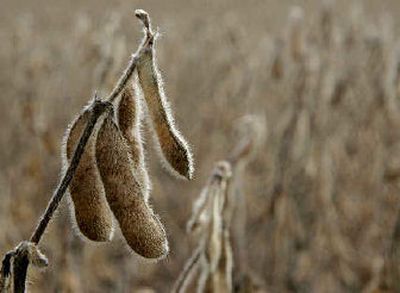Farmers get squeezed

WASHINGTON — The government raised its estimate of the size of this year’s corn and soybean crops and predicted prices will continue to drop, further stressing farmers whose production costs have soared along with energy prices.
In the monthly crop report issued Thursday, department analysts raised the forecast for corn production by 175 million bushels to 11.032 billion bushels and said prices should be $1.60 to $2 per bushel, down 5 cents from last month’s estimate. The average price last year was $2.06.
The soybean crop should top 3 billion bushels, an increase of 76 million over last month’s estimate, the department said. Prices should be $4.95 to $5.75, down 5 cents from last month’s estimate, according to the report. Last year’s price averaged $5.74.
The drop in prices comes as farmers are struggling with higher costs.
The cost of oil and gas affects everything on the farm, from irrigation to operating combines and tractors to transporting harvested crops. Ryan Niebur, who farms 4,500 acres near Akron, Colo., said the cost to irrigate an acre of his land has risen from $50 two years ago to $158.
Niebur’s diesel fuel expense has risen from $60,700 last year to more $135,000, he told members of the Senate Agriculture Committee on Wednesday. “Remember, the price of corn has not increased, nor has the yield.”
The cost of transporting crops has also soared, but high energy prices aren’t the only reason why. Damage to Gulf Coast shipping ports from hurricanes Katrina and Rita created backlogs of grain-laden barges along the Mississippi River, resulting in higher prices for chartering barges and driving up demand and rates for shipping by rail.
The squeeze on farmers is stretching nation’s grain storage capacity, according to the department’s chief economist, Keith Collins. Collins said farmers may have to store their crops on the ground, pay for commercial storage or sell at lower cash prices.
Added costs will also affect the price of food at the supermarket, which are expected to rise from 2.5 percent to 3.5 percent this year, Collins said. Food prices rose about 3.4 percent last year.
Kraft Foods Inc., the biggest U.S. food manufacturer, said Tuesday it’s raising prices by an average of 3.9 percent on many of its products because of higher energy and packaging costs.
Also in the crop report:
•The wheat crop should be 2.098 billion bushels, unchanged from last month’s estimate and down from last year’s 2.158 billion bushels. The expected price range narrowed to $3.25 to $3.55, from $3.20 to $3.60 last month and $3.40 last year.
• The forecast for rice prices rose 30 cents from last month to $7.75 to $8.05 per hundredweight. Projected production dropped 2.5 million hundredweight from last month’s estimate to 220.7 million hundredweight, but it still should be the second-biggest crop ever.
• Sugar imports rose 115,000 tons because of imports from Nicaragua following passage of the Central American Free Trade Agreement and increased imports from Mexico.
• The outlook for cotton improved 2 percent over last month’s estimate to 23.2 million bales because of increased production in every region but the far West.
•Analysts haven’t determined the impact last month of Hurricane Wilma on Florida, although they said sugarcane yield is likely to drop. The department will update its forecast for citrus next month.